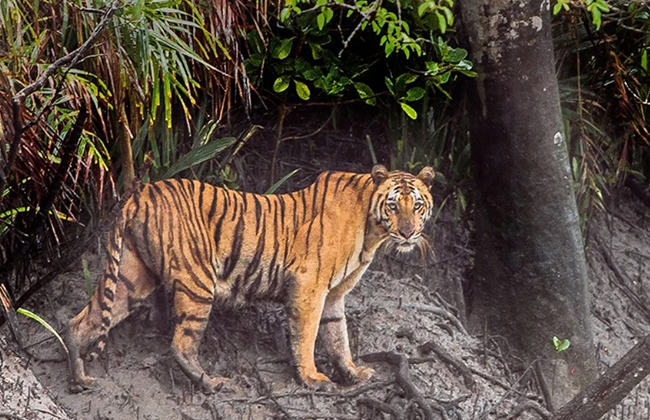
The Indian leopard (Panthera pardus fusca), locally known as chitah bagh in Bangladesh, is mostly found in the northern and northwestern region of the country, where they often fall victim to conflicts with humans.
Most leopards have always been found in the northern districts close to Bangladesh’s border with India — Panchagarh, Thakurgaon, Kurigram, Lalmonirhat and Nilphamari. About 10 leopards were beaten to death in these districts in the last 14 years, according to media reports.
Once leopards enter human settlements in search of food, very few leopards manage to return to the wild, as most of those are killed by the locals. In the latest incident, on Feb. 2, 2024, a leopard was beaten to death in Panchagarh when it entered the village in search of food.
“Since 2007-08, leopards have been found in the northern and northwestern region of Bangladesh. There was no report of leopards attacking humans, but every time, local people killed the big cats,” Muntasir Akash, a wildlife biologist and assistant professor at the University of Dhaka, told Mongabay.
There is a comparitively remarkable leopard population in Indian West Bengal’s bordering Jalpaiguri, Cooch Behar and Alipurduar districts close to Bangladesh, where they roam the tea gardens, coexisting with people.
“Our Teesta-Brahmaputra basins are topographically similar to the areas of West Bengal where leopards live. It is often said that leopards come from India in search of food. But there is no research on whether they come from India or there is a steady population in the northwestern region of Bangladesh,” Akash said. “There is a gap of research on leopards.”
According to the IUCN Bangladesh red list, the leopard is critically endangered in Bangladesh as its population is no longer viable now.
Once, the leopard was prevalent across the country in most habitats, except a major portion of the Sundarbans. Until the end of the 19th century, the big cat roamed the forests of the Chittagong Hill Tracts (CHT), Madhupur Tract, Sylhet and Cox’s Bazar. Now, the species is completely absent from the Sundarbans and the country’s sal forests, while it is occasionally spotted in the tea gardens and evergreen forests of Sylhet, Chattogram and the CHT, and Cox’s Bazar.
The extent of occurrence and area of occupancy of this species in the country have been reduced by 90 percent.
Other reasons contributing to the rapid decline in leopard population are habitat fragmentation and degradation caused by the increase in human population and development projects associated with its growth, decline in its prey population, and poaching for trafficking.
A 2023 study revealed that the natural habitat has become critically fragmented, which is considered unlikely to support a viable population of leopards. The recurrent anthropogenic disturbances like forest encroachment, illegal logging and shifting cultivation in the hills have rendered these habitats inhospitable for the big cats.
Md. Rezaul Karim Chowdhury, divisional forest officer at Chittagong Hill Tracts (CHT) North Forest Division, said many endangered wild species, including the leopard, are found in the dense Kassalong reserve forest, but the forest has become restricted now due to the prevalence of armed insurgent groups there.
So, he said, there is no project to conserve the leopard in these forests. However, the forest officer stressed the need to take the initiative to protect the leopard in all of its habitats, including the CHT.
The 2023 study recommends conducting systematic surveys in northeastern transborder forests and the CHT to know the actual status of leopard population.
It also suggests following improved conflict mitigation practices to conserve wildlife beyond protected areas for transient leopard conflicts in the country’s northwestern region.
Wildlife biologists said the CHT is the best hope for Bangladesh against losing its leopards completely and a systematic survey should be conducted on leopards to find ways to conserve the big cat in the region.
Akash said the neglected, yet magnificent and extremely adaptable, leopard should be brought into national conservation focus in Bangladesh to protect the species from extinction.
Rafiqul Islam is an environment and development journalist based in Dhaka, Bangladesh. He has been reporting on the environment, climate change, conservation, development and human rights.


